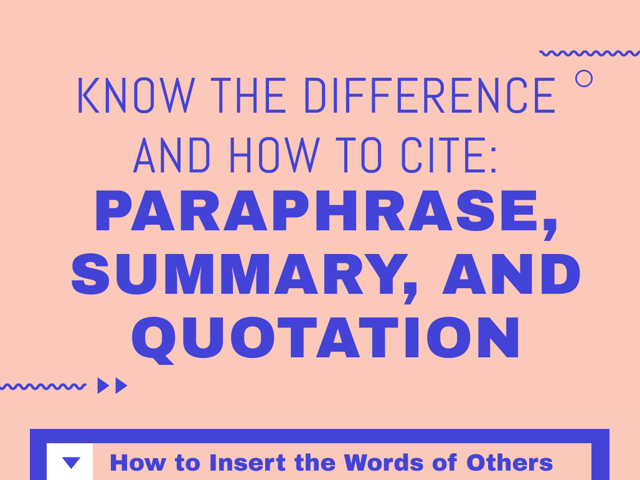
Know the Difference and How to Cite: Paraphrase, Summary, and Quotation
When given a writing task, the directions often require you to use evidence to support your ideas and admonish you to be sure to “cite your sources.” But what does that mean and under what circumstances must you cite the ideas of others in your own writing?
How to Insert the Words of Others
The three most common ways to use the words or ideas of others in your own writing is to quote, paraphrase, or summarize the ideas you hear or read that you like or recognize will support your own argument or position. No matter the form the words take, any time you use the words, ideas, interpretations, or analyses of someone else, you must cite that source. More about citations in a moment—let’s first discuss and define those three ways to use the words of others in your own writing.
Quoting Directly
Probably the most easily identifiable and commonly used approach to incorporating the words of others, quotations involve using the source’s actual words directly in one’s own writing. To signify that it is a quotation, quotation marks are put around text that comes directly from another source.
Paraphrasing
Paraphrasing is putting the words of others into your own words. When you’re writing, it can sometimes be cumbersome to find just the right quotation to use to support your ideas, so instead you might translate the source’s ideas into your own words and incorporate those into your writing. They still need to be cited.
Summarizing
When you summarize a source, you are condensing a longer text down to its main ideas and points, leaving out the small details. But you are still using the ideas of another in your writing, so you must cite your source so the reader knows where these ideas came from.
How These Methods Look in Writing
When Used as a Quotation
In Steve Jobs’ 2005 commencement speech to Stanford graduates, he encourages them to “find what you love…the only way to do great work is to love what you do. If you haven’t found it yet, keep looking. Don’t settle.”
When Paraphrased
In Steve Jobs’ 2005 commencement speech to Stanford graduates, he encourages them to pursue their passions as they prepare to enter the world and to not settle for doing something they don’t love because great work comes from having a passion for that work.
When Summarized
In Steve Jobs’ 2005 commencement speech to Stanford graduates, he encourages them to pursue what they love and not settle for anything less.
When to Cite a Source
When you use evidence, it is critical that you cite that evidence appropriately so that you are not plagiarizing the words or ideas of another. That’s right, using the ideas of another person, even if you don’t use their exact words, is a form of plagiarism if you don’t give that person credit. Now, everyday “common knowledge” ideas don’t need citation precisely because they are common knowledge. But interpretations of texts, analyses of ideas, or explanations of subjects are likely evidence that needs to be cited. It can get tricky, but the rule of thumb is, when in doubt, cite!
Citing Sources In Standardized Test Writing
When you are writing for an assessment, you will likely still be using evidence to support your ideas and claims. This means that you should include in-text citations with as much information about your source as you have. This includes the author’s name, the title of the source, the date of publication (if you know it), and the occasion or context in which it was provided.
For example:
In Steve Jobs’ 2005 commencement speech to Stanford graduates, he encourages them to pursue what they love and not settle for anything less.
This sentence gives credit to the author (Steve Jobs), the date he spoke the words (2005), and its context (commencement speech). The reader will then know your source and could research “Steve Jobs commencement speech” if they wanted to learn more about it after reading your text.
Although you may not have access to all of the bibliographic information for a particular source you want to use or refer to, use as much as you can to give credit to the author and his or her work. Even “anonymous” may be credited:
As an anonymous wise person once shared, “Ambition is putting a ladder against the sky.”
Remember, when in doubt, cite your source. It is better to err on the side of caution than risk not acknowledging a source and committing plagiarism.

Keep Reading

ACCUPLACER Test Blog
What’s a Good Score on the ACCUPLACER?
The ACCUPLACER test, particularly in its latest incarnation as the Next…

ACCUPLACER Test Blog
How to Do Well on the ACCUPLACER Essay
Navigating the ACCUPLACER essay, also known as the WritePlacer, can fee…

ACCUPLACER Test Blog
Essay Writing Practice and Prompts for the ACCUPLACER
The essay portion of the ACCUPLACER is the WritePlacer®. It evaluates y…